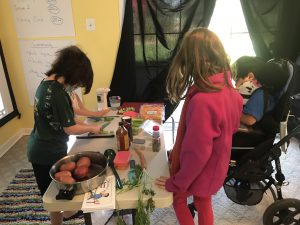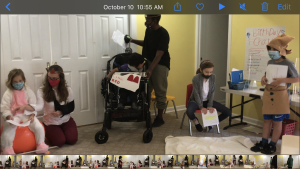 As our inclusive pod goes on I continue to contribute much of the success to the theory that if you plan for the students on the two extremes of your group – those who may need the more intensive support and those who may need extensions, then in the end you will have reached everyone’s needs, including the students falling in the middle.
As our inclusive pod goes on I continue to contribute much of the success to the theory that if you plan for the students on the two extremes of your group – those who may need the more intensive support and those who may need extensions, then in the end you will have reached everyone’s needs, including the students falling in the middle.
One aspect that allows us to do that is our unit planning. Our year long study is around the concept of community – what is a community, who makes up a community, and what does a community do. While this concept seems simple on the outside, each unit we have done has taken us further into answering this question.
To date, our units have included following traditional stories such as the Little Red Hen and Stone Soup, looking to solve a community problem such as how to move halloween candy from a safe six foot distance, an all about me unit (the individuals within a community), an election unit (how communities make collective decisions) and a unit around the communities of the pilgrims and Wampanoag from the first Thanksgiving. While not every individual lesson within reading and math assignments corresponds with the broader unit we are studying at the time, the main project or focus for each day does. This allows us to get creative with how to fit students’ individual needs into the lessons.
 In our current Stone Soup unit we read multiple examples of the stone soup story. We then made our own stone soup one Saturday, which allows the students to chop (with a child-friendly knife), stir, measure, and mix the soup together. Broader activities like cooking give us opportunities for each child to get involved in their own way – whether it is estimating how much of a certain vegetable we need, doing the fraction math for measuring spices – (how many 1/4s do we need to make 3/4s?), or simply using fine motor skills to stir and pour. Better yet, these opportunities are part of building our own community – we are living what we study and working together to create a final product we will all enjoy.
In our current Stone Soup unit we read multiple examples of the stone soup story. We then made our own stone soup one Saturday, which allows the students to chop (with a child-friendly knife), stir, measure, and mix the soup together. Broader activities like cooking give us opportunities for each child to get involved in their own way – whether it is estimating how much of a certain vegetable we need, doing the fraction math for measuring spices – (how many 1/4s do we need to make 3/4s?), or simply using fine motor skills to stir and pour. Better yet, these opportunities are part of building our own community – we are living what we study and working together to create a final product we will all enjoy.
Our third grader writers are currently working on their own version of the Stone Soup script and the rest of us will be creating our costumes and practicing our lines shortly. Again, this unit planning allows us to meet everyone’s needs – whether through creative writing, practice reading, or working on problem solving and flexibility while planning the sets.
Within each unit we work to identify the goal for the different students groups – what is our focus for the third graders? First graders? What is our communication goal? What similarities do we have between these goals? Is this something we can discuss in our group meeting? For both our election and Thanksgiving unit we included map skills, with different goals and questions planned for each of the different groups. Although the whole group may gather around a map, the questions are intentionally tiered for both third and first grade so that everyone is participating in the conversation. You never know when a first grader picks up on the greater concept, or the third grader benefits from the first grade review.
I am looking forward to watching our Stone Soup unit wrap up with another play and moving into a giving back to our community unit. Stay tuned for more work from our inclusive group of kids!

 we wanted to do a project that dealt with thankfulness, but hadn’t found one yet.
we wanted to do a project that dealt with thankfulness, but hadn’t found one yet.
 This project was a great reminder of two important elements in inclusion –
This project was a great reminder of two important elements in inclusion – 
 Our Augmentative Learning Program Study (ALPS) performed their first Readers’ Theater!
Our Augmentative Learning Program Study (ALPS) performed their first Readers’ Theater! 
 Our Inclusive AAC Learning Group officially began September 14, 2020. After what somehow felt both like months of planning and yet still not enough time to be ready, we opened our group to a small but eager group of first through third grade students on Monday afternoon. We are looking forward to welcoming more students, but are taking advantage of the small group to find our sea legs and develop our rhythm.
Our Inclusive AAC Learning Group officially began September 14, 2020. After what somehow felt both like months of planning and yet still not enough time to be ready, we opened our group to a small but eager group of first through third grade students on Monday afternoon. We are looking forward to welcoming more students, but are taking advantage of the small group to find our sea legs and develop our rhythm.
 h our knowledge grow. My hope through this process is that we engage all the students in deeper thinking and understand that everything we learn can help us answer broader life questions.
h our knowledge grow. My hope through this process is that we engage all the students in deeper thinking and understand that everything we learn can help us answer broader life questions.
